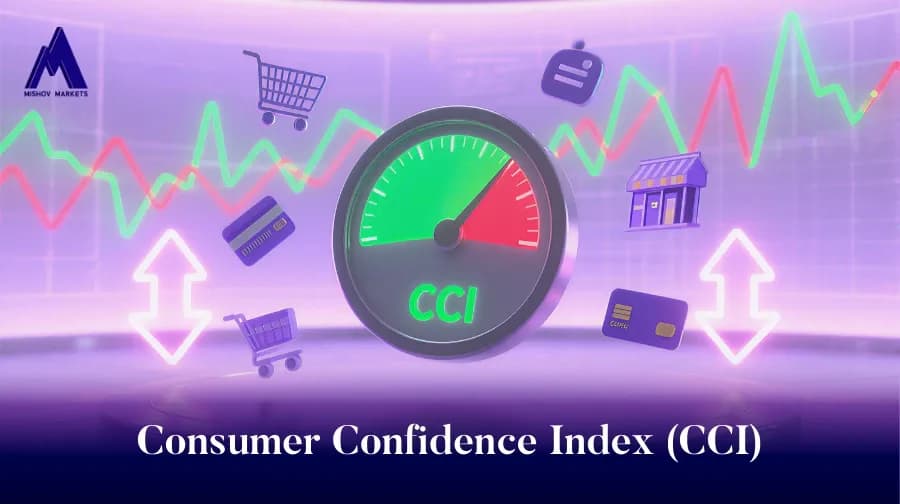Consumer Confidence Index

Consumer Confidence Index (CCI) is a vital economic report that offers a revealing glimpse into the hearts and minds of households, wielding an indirect yet potent influence on the markets. More than just a collection of data, it is a significant barometer of the overall economic climate, reflecting the collective optimism or pessimism of consumers. To truly understand its implications, let's take a trip to the bustling metropolis of Econville and hear from the esteemed Dr. Mishov, who will break down how this crucial indicator helps us predict the economic tides and what it signals for the financial future.
The Consumer Confidence Effect on the Economy
Once upon a time in Econville, Dr. Mishov, the town's intelligent economist, noticed a drop in gold prices, which made him cautious about the reasons for this price shift and led him to observe a dramatic change in the town's atmosphere. Although the bustling marketplaces had slowed down, new business endeavors had been put on hold, and residents of the town were spending less money even on necessities, it was clear that something peculiar was taking place among the populace. People were pessimistic, the shops appeared to be quieter, and the number of new businesses opening their doors had slowed down. Following this observation, Dr. Mishov came to the conclusion that the Consumer Confidence Index of Econville had reached a stage of low confidence.
While Dr. Mishov was addressing the citizens of Econville in the town square, he noted that the level of consumer confidence is essentially a reflection of people's expectations for the economy.
In his explanation to the citizens of the town, Dr. Mishov noted that consumer confidence is a reflection of how optimistic or pessimistic people are about this economy. People have a tendency to spend more money when they have an optimistic perspective, when they believe their level of income is stable, and when they feel secure in their jobs. In turn, this spending provides fuel for local firms, which in turn stimulates output, produces additional jobs, and ultimately brings an end to a cycle of expansion. This spending boosts the economy by generating demand for businesses, jobs, and output, which in turn drives the economy ahead. However, if individuals are uncertain about the state of the economy, they will reduce their spending, which would eventually slow down this economic engine.
For the purpose of providing further illustration, Dr. Mishov established a connection between the confidence of consumers and another significant economic data, which is the unemployment rate and GDP. During his explanation, he mentioned that these two measures frequently collaborate in a cycle. The confidence of consumers is negatively impacted when unemployment rates are high since fewer people have stable incomes for themselves. As a result of being less confident in their job security and incomes, the citizens of the town will reduce their spending, which will result in slower growth of the economy. When unemployment rates are low, on the other hand, a greater number of individuals have jobs, consistent paychecks, and the economic confidence to spend.
On the other hand, he mentioned that when individuals are uncertain about the future of the economy, they begin to decrease their spending and increase their savings, which can slow down the economy. "When consumers have a high level of confidence," Dr. Mishov stated, "they contribute to the forward movement of the economy." However, if they have a low level of confidence, they will begin to hold back, which might cause the economy to begin to slow down or even shrink.
After that, Dr. Mishov presented a plan: if the officials of the town paid attention to the creation of additional work opportunities, they would be able to lower the rates of unemployment. In turn, this would most likely result in an increase in consumer confidence. In a favorable economic cycle, the confidence of consumers would increase, which would result in the citizens of the town spending more money, businesses flourishing, and an increase in the number of jobs available.
During the subsequent months, Econville gradually started to recover as a result of the implementation of new job initiatives and the emphasis placed on strengthening the town's confidence. The markets became more lively, businesses reopened, and people saw an increase in their level of optimism. Econville had been put back on the path to prosperity as a result of the interaction between consumer confidence and the unemployment rate. This interaction demonstrated to the citizens of Econville that these economic indicators were, in fact, the heartbeat of their city.
How the Consumer Confidence Index Is Calculated
The Consumer Confidence Index is derived from a survey that is carried out on a monthly basis by organizations such as the Conference Board in the United States (CB Consumer Confidence) and other statistical agencies in a variety of nations. The purpose of this survey is to inquire about the financial well-being, job circumstances, and spending expenditure of a sample of households that is typical of the population. An index that indicates the level of optimism or pessimism that consumers have regarding the current state of the economy is created using the responses taken from the survey.
1. Conducting a Survey of Household Sentiment: Several questions concerning the present and future economic situations are posed to respondents, including the following:
-
Is the current state of business better, worse, or the same as before?
-
Is employment numerous, difficult to obtain, or has it not changed?
-
What is your forecast for the economy's performance in the upcoming six months?
2. Scoring and Index Manufacturing: The responses are scored and weighted, which results in the production of two primary sub-indices:
-
The Present Situation Index illustrates how respondents feel about the state of the economy at the moment.
-
Expectations Index: Reflects outlook for the next six months.
3. Benchmarking: These scores are indexed to a benchmark year, which is commonly calculated to be 100 (in the United States, this was calculated to be 1985). Variations in the index are a reflection of changes in the sentiment of consumers.
Interpreting the Consumer Confidence Index
The confidence of consumers provides traders with valuable information regarding the possibility of changes in consumer spending, which is a significant economic driver. One way to view these data is as follows:
-
The rising consumer confidence index (CCI) indicates optimism and suggests that consumers are likely to increase their spending. This has the potential to provide a favorable influence for consumer-driven industries such as retail, technology, and discretionary items. It is possible that traders would read the increase as a signal for potential growth in these sectors, which will induce them to make purchases.
-
At the beginning of 2021, the Consumer Confidence Index (CCI) in the United States experienced considerable increases as consumers became more optimistic about the recovery occurring after the pandemic. When the Consumer Confidence Index (CCI) was high, it showed that consumers felt safe enough to spend more money, particularly in discretionary industries such as retail, hospitality, and travel. This pattern was seen by traders, who anticipated that businesses operating in these industries, such as Delta Airlines and Target would see positive results. Following the return of customers to their shopping, dining, and traveling activities, many individuals made decisions to purchase these equities in the expectation of increasing profitability.
-
Declining CCI: A falling CCI reflects pessimism and indicates that consumers are spending less money due to concerns about the economy or their job security. This may have a negative impact on the markets, particularly in industries that are intimately connected to consumer spending. It is possible that traders would become more cautious or perhaps take short positions in certain industries on account of the current circumstances.
-
At the beginning of 2008, as the United States financial crisis was unfolding, consumer confidence began to plunge. The CCI levels decreased significantly, which indicated that consumers were skeptical of the current economic situation. This resulted in a reduction in spending across the majority of industries. This downward trend was viewed by traders as a pessimistic indication, particularly for stocks that are sensitive to consumer sentiment. They anticipated losses in areas such as housing, retail, and luxury goods as a result of consumers' decreasing spending, and as a consequence, they shifted out of these companies or even took short positions when they anticipated these losses.
-
Comparing Present and Expectations Indexes: In the event that the Present Situation Index is high but the Expectations Index is low, it may be an indication that customers are concerned about the future, although they are satisfied with the current circumstances. As investors attempt to forecast future performance, this disparity can be interpreted as an indication of uncertainty, which in turn makes markets more volatile.
-
In June of 2022, the Present Situation Index for the United States remained reasonably high, while the Expectations Index experienced a significant decline. The existence of this gap indicated that although individuals were largely content with the present, they were uncertain about the future job security and inflation they would face. Because traders viewed this as a sign of likely market instability, they started moving their investments to safer options like bonds. They anticipated that consumers would reduce their spending.
-
Historical Context and Trends: It is important for traders to consider the past trends in consumer confidence. When making trading decisions, it is beneficial for traders to take into account both short-term and long-term patterns in consumer confidence. On the other hand, if consumer confidence has been consistently increasing over the course of several months but suddenly declines, traders may see this drop as a warning sign that the market is about to undergo a correction. In contrast, if consumer confidence continues to be low but shows a slight uptick from one month to the next, the increase may indicate that economic conditions are beginning to stabilize, which may indicate the existence of prospects for financial expansion.
Every one of these examples demonstrates how traders incorporate CCI data into a more comprehensive analysis, making use of it in conjunction with other indicators to arrive at choices that are more well-informed regarding market trends and potential investment strategies.








